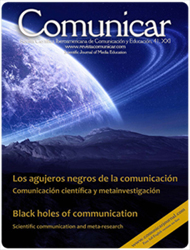El enmascaramiento como estrategia persuasiva en la publicidad para jóvenes
DOI:
https://doi.org/10.3916/C41-2013-15Palabras clave:
Enmascaramiento, atención, educación informal, publicidad, persuasión, juventud, hiperestimulación cognitivaResumen
Young people today live in a media culture where the content they access and circulate through by means of different audiovisual technological devices is part of their informal education. In this context, the traditional advertising inserted into these media is giving way to new strategies through which advertising is masked within other content consumed by young people. They believe they are sufficiently wellinformed to consider advertising's influence on them to be relative, and claim to be equipped with effective strategies that immunize them against it. However, as argued in this article, current advertising is implementing new persuasive forms that go unnoticed. We present an empirical investigation involving 154 students. Through an interactive computing device, the students processed a total of 223 stimuli corresponding to a graphic communication medium. The dependent variables include the degree of success in identifying the presence of advertising in the stimuli and reaction time. The results show how new masking strategies in advertising hinder young people's awareness that they are receiving advertising messages. This facilitates a failure to create counterarguments. The results of this work open up the discussion of whether it is relevant to make known to young people, as part of their education and training, these current effective advertising strategies deriving from informal education systems.Descargas
Publicado
2013-06-01
Número
Sección
Investigaciones
Licencia
Las obras se publican en la edición electrónica de la revista bajo una licencia Creative Commons Reconocimiento-NoComercial-SinObraDerivada 3.0 España: se pueden copiar, usar, difundir, transmitir y exponer públicamente, siempre que:
a) Se cite la autoría y la fuente original de su publicación (revista, editorial y URL de la obra).
b) No se usen para fines comerciales.
c) Se mencione la existencia y especificaciones de esta licencia de uso.

